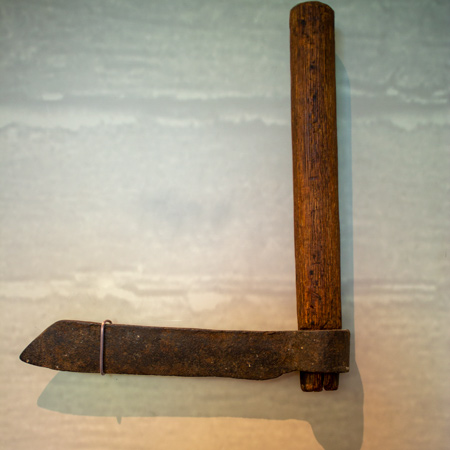Sgt. Ordway is hopeful that their cottonwood logs will rive well—split into boards. He reports that they will have to give up on that plan. Interpreter René Jusseaume says that traders from Canada have arrived at the Hidatsa villages, and some Mandans bring their horses to graze near the partially built Fort Mandan.
The Northern Lights
by Yellowstone Public Radio[1]Originally aired weekdays by Yellowstone Public Radio during the Bicentennial observance of 2003-2006. Narrated by Hal Hansen. Scripts by Whit Hansen and Ed Jacobson. Produced by Leni Holliman. © … Continue reading
Canadian Traders
Jussome [René Jusseaume] our interpreter went to the Village, on his return he informed us that three English men had arrived from the Hudsons Bay Company, and would be here tomorrow
—William Clark
Riving Cottonwood
we continued building with as much haste as possable in order to Git in them before winter Sets in. we found that the C. W. [cottonwoods] will rive well So that we are in hopes to make enofe to cover our buildings. but afterwards found it difficult and Gave up the Idea.
—John Ordway
Grazing Horses
many [Mandan] Indians Come to See us and bring their horses to Grass near us
—William Clark
The Mandan horse owners may have been trying to prevent their stock from being stolen by other Nations.[2]Clay S. Jenkinson, A Vast and Open Plain: The Writings of the Lewis and Clark Expedition in North Dakota, 1804–1806 (Bismarck, North Dakota: State Historical Society of North Dakota, 2003), 113.
Weather Diary
Ther. at rise
Weather Wind at rise
Thert. at 4 P.M. Weather Wind at 4 P.M. 38 cloudy S 39 cloudy W. Since we have been at our present station the River has fallen about nine inches
—Meriwether Lewis[3]To assist the reader, the editor of this web page has omitted the “day of the month” and “River Feet” columns and spelled out some abbreviations.
Fort Mandan is a High Potential Historic Site along the Lewis and Clark National Historic Trail managed by the U.S. National Park Service. The North Dakota Department of Parks and Recreation manages a modern reconstruction and the Lewis and Clark Interpretive Center located at US Hwy 83 and ND Hwy 200A.
Knife River Indian Villages National Historic Site is a High Potential Historic Site along the Lewis and Clark National Historic Trail managed by the U.S. National Park Service. A unit of the National Park System, the site is located at 564 County Road 37, one-half mile north of Stanton, North Dakota. It has exhibits, trails, and a visitor center.
Notes
| ↑1 | Originally aired weekdays by Yellowstone Public Radio during the Bicentennial observance of 2003-2006. Narrated by Hal Hansen. Scripts by Whit Hansen and Ed Jacobson. Produced by Leni Holliman. © 2003 by Yellowstone Public Radio. |
|---|---|
| ↑2 | Clay S. Jenkinson, A Vast and Open Plain: The Writings of the Lewis and Clark Expedition in North Dakota, 1804–1806 (Bismarck, North Dakota: State Historical Society of North Dakota, 2003), 113. |
| ↑3 | To assist the reader, the editor of this web page has omitted the “day of the month” and “River Feet” columns and spelled out some abbreviations. |
Experience the Lewis and Clark Trail
The Lewis and Clark Trail Experience—our sister site at lewisandclark.travel—connects the world to people and places on the Lewis and Clark Trail.
Discover More
- The Lewis and Clark Expedition: Day by Day by Gary E. Moulton (University of Nebraska Press, 2018). The story in prose, 14 May 1804–23 September 1806.
- The Lewis and Clark Journals: An American Epic of Discovery (abridged) by Gary E. Moulton (University of Nebraska Press, 2003). Selected journal excerpts, 14 May 1804–23 September 1806.
- The Lewis and Clark Journals. by Gary E. Moulton (University of Nebraska Press, 1983–2001). The complete story in 13 volumes.




